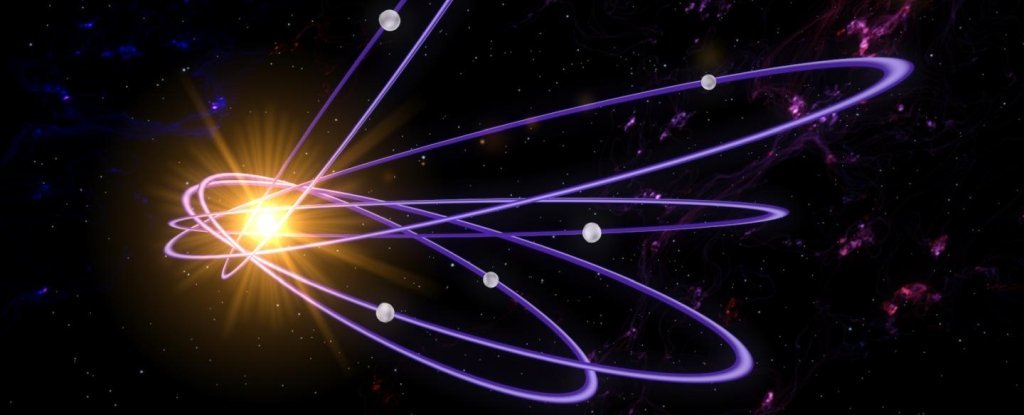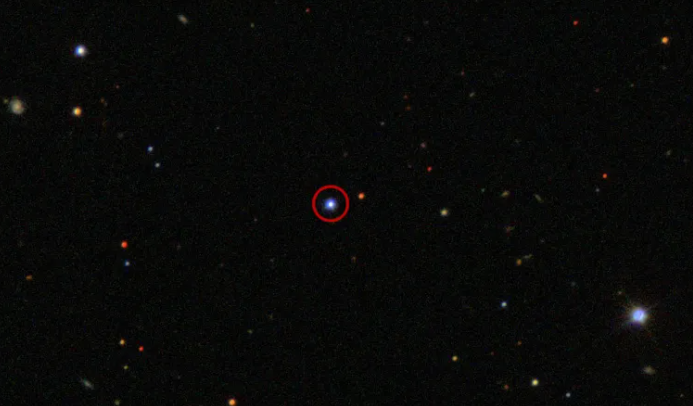Most of the Solar System is pretty well behaved, but in the distant reaches, out past the orbit of Neptune and far from the light of the Sun, things can get a little… strange. There are a bunch of rocks orbiting the Sun in patterns totally different from the objects found closer in.

Because of this apparent detachment from the rest of the Solar System, these dark, icy bodies are known as “detached objects”, and astronomers have been searching for an explanation of why they act so weirdly.
By far, the most well-known explanation would be the hypothetical existence of Planet Nine – a large, unseen planet lurking about in the Solar System’s fringes, gravitationally bumping these detached objects into their strange orbits.
But Planet Nine is not the only option, and now a pair of astrophysicists believes they have found the best explanation yet. According to their analysis, it’s not Planet Nine wrecking those detached orbits. Rather, they find the collective gravity of the detached objects themselves has introduced instabilities that shifted the orbits over millions of years.
“This region of space, which is so much closer to us than stars in our galaxy and other things that we can observe just fine, is just so unknown to us,” explained astrophysicist Ann-Marie Madigan of the University of Colorado Boulder.
“We’re the first team to be able to reproduce everything, all the weird orbital anomalies that scientists have seen over the years.”
Although we can’t see what’s out past Neptune easily – it’s hard to see something even a few hundred kilometres across where so little light reaches – there’s a growing body of evidence for a reasonably populated region.
We’re not talking about the Kuiper Belt, which extends from just beyond the orbit of Neptune, around 30 astronomical units (AU), to a little way beyond the farthest point on the orbit of Pluto, about 55 astronomical units. The behaviour of Kuiper Belt objects is well understood, for the most part.
Detached objects are even farther from the Sun. There’s Leleākūhonua, which only comes as close as 65 AU at perihelion, or its closest approach to the Sun, with an aphelion at 2,106 AU. Sedna swings between 76 and 937 astronomical units. FarFarOut was detected at a distance of 140 AU. You get the idea.
And it’s not just the distance. These bodies aren’t on nice, tidy orbits. Instead, their orbits are usually highly elliptical, and on a tilted angle relative to the more-or-less flat plane of the Solar System, two properties known respectively as eccentricity and inclination. Also, the bodies occasionally seem to come into alignment, suggesting a common instigator for all the strangeness.
To find an explanation for what’s going on, Madigan and her colleague, astrophysicist Alexander Zderic of the University of Colorado Boulder, conducted simulations of the outer Solar System, using the power of a supercomputer for the computationally intense task of accounting for the collective and individual masses of these outer Solar System objects.
This is not dissimilar to research conducted by the pair and published in 2018, but the new simulation was updated to be more realistic.
“We modelled something that may have once existed in the outer Solar System and also added in the gravitational influence of the giant planets like Jupiter,” Zderic said.
Their simulation covered the region between 100 and 1,000 astronomical units, and ran for a variety of configurations and a range of masses, with a starting point of an orderly orbit around the Sun.
The detached objects did not remain orderly for long, particularly at the higher collective masses. As time passed in the simulation, the objects started to interact – pushing and pulling each other, and knocking off course.
In the end, the simulation achieved a result that looks a lot like the orbits of the detached objects today. It did, however, require a fair bit of mass in the outer Solar System.
“You needed objects that added up to something on the order of 20 Earth masses,” Madigan said. “That’s theoretically possible, but it’s definitely going to be bumping up against people’s beliefs.”
That total mass is also a fair bit chonkier than Planet Nine. Nevertheless, the result is a strong competitor to the Planet Nine theory, especially since Madigan, Zderic and their colleagues aren’t the only team to have demonstrated the possibility that a bunch of rocks could be the culprit.
In addition, two separate surveys have identified new swarms of detached objects – data incorporated into the simulations – that show no evidence of the seeming alignment thought to indicate the presence of Planet Nine.
But we’re probably going to have to wait for better instruments to finally make a ruling one way or the other.
“A lot of the recent fascination with the outer Solar System is related to technological advances,” Zderic said. “You really need the newest generation of telescopes to observe these bodies.”








 Photographer Finds Locations Of 1960s Postcards To See How They Look Today, And The Difference Is Unbelievable
Photographer Finds Locations Of 1960s Postcards To See How They Look Today, And The Difference Is Unbelievable  Hij zet 3 IKEA kastjes tegen elkaar aan en maakt dit voor zijn vrouw…Wat een gaaf resultaat!!
Hij zet 3 IKEA kastjes tegen elkaar aan en maakt dit voor zijn vrouw…Wat een gaaf resultaat!!  Scientists Discover 512-Year-Old Shark, Which Would Be The Oldest Living Vertebrate On The Planet
Scientists Discover 512-Year-Old Shark, Which Would Be The Oldest Living Vertebrate On The Planet  Hus til salg er kun 22 kvadratmeter – men vent til du ser det indvendigt
Hus til salg er kun 22 kvadratmeter – men vent til du ser det indvendigt  Superknepet – så blir snuskiga ugnsformen som ny igen!
Superknepet – så blir snuskiga ugnsformen som ny igen!  Meteorite That Recently Fell in Somalia Turns Out to Contain Two Minerals Never Before Seen on Earth
Meteorite That Recently Fell in Somalia Turns Out to Contain Two Minerals Never Before Seen on Earth  Nearly Frozen Waves Captured On Camera By Nantucket Photographer
Nearly Frozen Waves Captured On Camera By Nantucket Photographer  It’s Official: Astronomers Have Discovered another Earth
It’s Official: Astronomers Have Discovered another Earth 